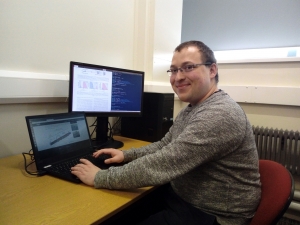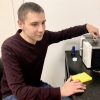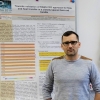Funds for or talented young scientists
2019.11.20 15:31 - Marek PawłowskiYoung scientists from NCBJ have obtained prestigious funds to conduct their work. Sebastian Trojanowski, PhD, conducting theoretical research, including related to the mystery of dark matter, has received a scholarship from the Minister of Science and Higher Education for outstanding young scientists. Łukasz Bartosik, PhD Eng, received a NCN Miniatura grant for the study of new amino acid-based detectors. As part of the NCN Preludium grant, Tomasz Kwiatkowski, MSc Eng, will model turbulent flows of coolant in reactor fuel cartridges.
Sebastian Trojanowski, PhD, is a graduate of the MISMaP College of the University of Warsaw, where he earned himself a master’s degree in physics and chemistry and a bachelor’s degree in mathematics. He associated his further career development with the group for theoretical elementary particle physics in NCBJ, where he also defended his doctoral dissertation with a distinction. Since then, he has been associated with the Theoretical Physics Division at the NCBJ Basic Research Department. As a scholarship holder of the Mobility Plus program, he went on a two-year internship at the University of California in Irvine, USA. Currently he is on a similar internship on the University of Sheffield in the UK.
In his scientific work, Trojanowski, PhD, focuses on various aspects of physics on the smallest scale of the so-called elementary particles. He conducts theoretical research, but values the closest possible contact with experimental physicists, he would always like to be close to a possible breakthrough scientific discoveries. He is one of the four originators of the new experiment (called FASER) at the Large Hadron Collider facility. The experiment will focus on searching for traces of the so-called new physics, going beyond or previous our previous knowledge of matter, as well as on analysing the properties of the so-called neutrino. In his research, Trojanowsk, PhD, also deals with the issue of dark matter, which is one of the dominant components of the universe that surround us, although its nature remains a mystery.
Łukasz Bartosik, PhD Eng, obtained his doctorate in chemistry at the Institute of Physical Chemistry of the Polish Academy of Sciences and currently leads the Radiochemistry Department at the NCBJ Division of Reactor Research. His research, planned as part of the Miniatura project, will check whether amino acids other than alanine can be used as a gamma radiation detectors and dosimeters.
The principle behind the usage of amino acids in passive detectors is to break the C-N bond in the compound and create a stable radical, whose structure and quantity is determined by means of EPR spectroscopy (electron paramagnetic resonance). Amino acid-based detectors can potentially be used in biological research or medicine (e. g. BNCT therapy). The team led by Dr Bartosik intends to carry out research centred around analysing factors, such as the impact of the radical structure on the intensity and durability of the signal (the more stable the radical, the signal should be more intense and stable over time), the impact of the radical structure on the linearity of the detector, as well as the impact of substituents on the radical’s stability. The research has two main trends: qualitative, which consists of determining the structure of the resulting radical and comparing it with the simulations of the expected structure, and quantitative, in which the researchers examine the relationship between the dose and the read signal, especially after a longer time.
Tomasz Kwiatkowski, MSc Eng, works at the Division of Nuclear Energy and Environmental Studies in the NCBJ Department of Complex Systems. He submitted a project titled „The use of LES and hybrid turbulent models for precise predictions of coolant flow and heat exchange in tightly packed fuel cartridges” to the Preludium competition.
One of the basic aspects of safe operation of a nuclear reactor is the effective removal of accumulated heat inside the reactor. The most commonly used reactor coolant is water, although there are also designs that use liquid metals or gases. A coolant – regardless of its type – does not flow uniformly through the space inside the core. The actual flow is full of disturbances in the form of local turbulences. Currently, the tools at our disposal are not able to perfectly simulate the turbulence of the flow, which is nature is a very complex three-dimensional phenomenon. Therefore, the models that scientists and engineers use must be properly verified and improved. It is particularly important to be able to correctly describe the flow and heat exchange in fuel cartridges using advanced numerical simulations.
The main purpose of the research proposed in MSc Eng Kwiatkowski’s project is the validation and/or calibration of available and commonly used turbulence models. The implementation of this project will determine how good the low-order turbulent models are currently in relation to modelling coolant flow and heat exchange in tightly packaged fuel cartridges. The author predicts, that as a consequence a set of so-called best practices will be proposed, i. e. indications of how such analyses should be carried out. As a result, the scientific community, nuclear engineers, but also everyone involved in numerical fluid mechanics will receive an improved tool to obtain more reliable results.























